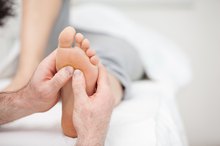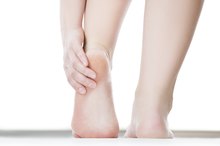4 Ways to Manage Your Knee's Scar Tissue After Surgery
Your knee is vital for everyday function. This important joint carries your body through every activity of your life. With injury, the knee joint and the adjoining tissues, ligaments and cartilage can be compromised, requiring surgery for repair. With surgery comes scar tissue, a very tough and inflexible fibrous material that can hinder the range of motion within your joint 1.
If you are experiencing serious medical symptoms, seek emergency treatment immediately.
It's not unusual to be self-conscious about scar tissue after knee surgery. Although it cannot be fully removed, it can be managed. In fact, scar tissue is essential to the healing process for the knee to eventually move and function properly again. Through various physical therapy interventions, including massage and other manipulation methods, scar tissue in the knee can be managed.
Read more: How To Prevent Scar Tissue Formation
Protect the Incision
Avoid stretching the skin around your surgical areas and the knee joint for the first 72 hours after surgery. Large incisions held together with stitches or staples are particularly vulnerable to opening back up, delaying healing. This can lead to additional scar tissue after knee surgery.
Swelling is common during this phase of healing. Apply the RICE method — rest, ice, compression and elevation — to help reduce swelling and pressure on your incision to lower your risk for excess scar development. Ice can be applied for 20 minutes at a time, every two hours.
An elastic bandage can be wrapped around your knee, from bottom to top, to help reduce and/or prevent swelling after surgery. The bandage should be snug, but you should be able to slide two fingers between it and your skin. Tingling, numbness or blue skin on your foot can indicate that the wrap is too tight. Elevate your leg above the level of your heart when resting.
- Avoid stretching the skin around your surgical areas and the knee joint for the first 72 hours after surgery.
- An elastic bandage can be wrapped around your knee, from bottom to top, to help reduce and/or prevent swelling after surgery.
Perform Scar Massage
How to Care for a Bruised Knee
Learn More
Once your incision is fully healed, perform scar massage over and around your scar 1. Intense pressure applied to the scar tissue will help break it up and flatten it out, ultimately making it less obvious.
HOW TO DO IT: Use lotion or cream, such as vitamin E or cocoa butter, to reduce friction between your fingers and your scar. Rub your scar from side to side, working along its full length. Begin gently to increase blood flow to the area; then gradually increase your pressure to a level that is uncomfortable but not highly painful. Repeat for several minutes twice a day.
- Once your incision is fully healed, perform scar massage.
- HOW TO DO IT: Use lotion or cream, such as vitamin E or cocoa butter, to reduce friction between your fingers and your scar.
Move Your Knee
Increasing range of motion in your knee will help stretch scar tissue and keep it from getting stiff. Once your incision is fully healed, perform range of motion exercises that force the knee to break through the scar tissue and increase the range of motion in the joint. Wall slides, patella mobes and other exercises can be done to help break up the scar tissue around the knee after surgery.
Physical Therapy Modalities
How to Wrap a Meniscus Injury
Learn More
There are several additional physical therapy interventions to help manage scar tissue after knee surgery. Physical therapy modalities, such as ultrasound, electrical stimulation and low-level laser therapy, are all used in conjunction with manual therapy to help flatten scar tissue after injury 3.
Read more: Foods That Help Heal Scars
Related Articles
References
- Strive4impact: Work With Your Own Scar Tissue
- StretchCoach: Pulled Muscles, Muscle Strain and Scar Tissue Treatment
- InTechOpen: Physical Agents in the Management of Wound(s)
- Shin TM, Bordeaux JS. The role of massage in scar management: a literature review. Dermatol Surg. 2012;38(3):414-23. doi:10.1111/j.1524-4725.2011.02201.x
- Ault P, Plaza A, Paratz J. Scar massage for hypertrophic burns scarring-A systematic review. Burns. 2018;44(1):24-38. doi:10.1016/j.burns.2017.05.006
- Cheatham SW, Lee M, Cain M, Baker R. The efficacy of instrument assisted soft tissue mobilization: a systematic review. J Can Chiropr Assoc. 2016;60(3):200-211.
- Kohata K, Itoh S, Horiuchi N, Yoshioka T, Yamashita K. Influences of osteoarthritis and osteoporosis on the electrical properties of human bones as in vivo electrets produced due to Wolff's law. Biomed Mater Eng. 2017;28(1):65-74. doi:10.3233/BME-171657
- Cheatham, S. Et al. The Efficacy of Instrument Assisted Soft Tissue Mobilization: A Systematic Review. J Can. Chiro, Assoc. 2016 Sep; 60(3): 200-11.
- Kim J, Sung DJ, Lee J. Therapeutic effectiveness of instrument-assisted soft tissue mobilization for soft tissue injury: mechanisms and practical application.Journal of Exercise Rehabilitation. 2017;13(1):12-22. doi:10.12965/jer.1732824.412.
- Kisner, C., & Colby, L. A. Therapeutic exercise: Foundations and techniques. (3 ed.). Philadelphia: FA Davis.
- Shin TM, Bordeaux JS. The Role of Massage in Scar Management: A Literature Review.Dermatologic Surgery. 2012;38(3):414-423. doi:10.1111/j.1524-4725.2011.02201.x.
Writer Bio
Colleen Meheen is a certified personal trainer through the ISSA, and has years of experience in the fields of holistic nutrition. Her passion for preventative wellness creates her active lifestyle up in the Rockies of Colorado. She has been the fashion editor for Lifestyle Media Group and an inspirational writer for Reign Media Group L.L.C.









